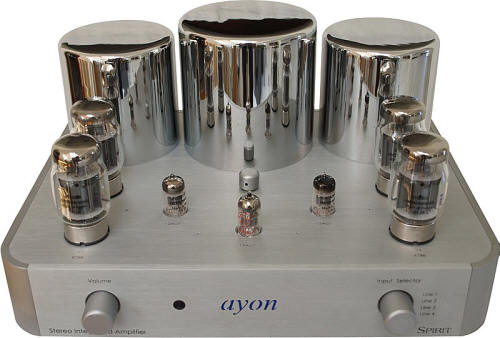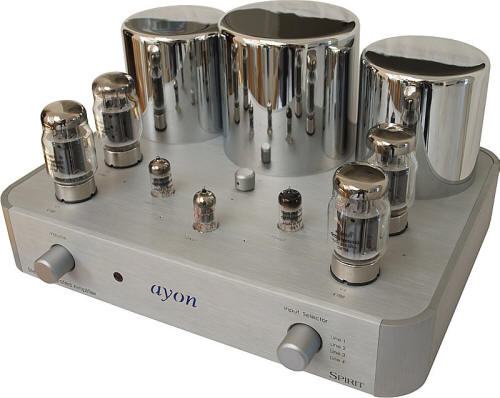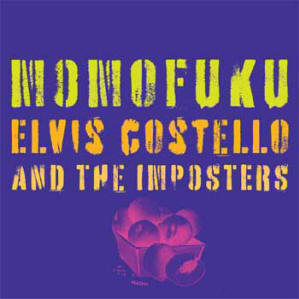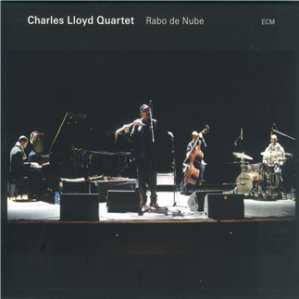
You are reading the older HTML site
Positive Feedback ISSUE
may/june 2008
ayon audio
Spirit integrated amplifier
as reviewed by Tom Campbell

|
TOM CAMPBELL'S SYSTEM
LOUDSPEAKERS
ELECTRONICS
SOURCES
CABLES
ACCESSORIES
|
Ayon Audio may not be a name you've heard before, but they are working hard to change that. The company—maker of a full range of audiophile products featuring all-tube amplifiers—has been around for twenty years, but is currently making a push to expand its market beyond its native Austria.
All of Ayon Audio's products are painstakingly designed and assembled in-house; the company even makes their own tubes. While they specialize in low-powered, single-ended designs, the Spirit integrated is the company's ostensible attempt to craft a more mainstream offering: switchable between push-pull pentode and triode operation, the Spirit pumps out a robust 50-watts per channel in pentode and 30-watts in triode. With a list price of $4000, the Spirit and the similar, triode-only Spark integrated, are Ayon's twin entry-level offerings.
Entry-level it may be, but the Spirit is still a gorgeously built amp. Having it in your listening room will instantly identify you as someone who is quite serious indeed about their music playback. Looking at the photograph on the Ayon website before actually receiving the amp, I completely misjudged the Spirit's scale, thinking it much smaller than it actually is. So I was surprised to see the FedEx guy standing on my sidewalk a week or two later, laboring to pull an enormous, and enormously heavy, box up my front steps on his cart. He placed the box at my feet and fled, clearly wanting no part of getting the package up to my second-floor apartment. With considerable effort I did it myself—something I wouldn't necessarily recommend to any of you out there.
I let the ice-cold block (this was early April in Boston) sit for 24 hours in my apartment to get to room temperature, and the next night I unpacked the 75-pound beast—19 inches wide, about 14 inches in depth, and more than 10 inches in height, with transformer towers the size of quart paint cans. Build quality in general is impeccable, and design features (brushed aluminum casework, chrome transformers) are of uniformly high quality.
The Spirit uses four KT88 (aka 6550) and three 12AU7 tubes. It is a zero negative feedback design and runs in pure Class A, making it one hot-running, power-sucking machine. The preamp section has four line levels and there are speaker taps for both 4-ohm and 8-ohm impedances. I found the 8-ohm setting to be the correct one for both my Harbeth 7-ES monitors and Spendor 3/1P mini-monitors.
Though an integrated, the Spirit occupies a spot on the audiophile spectrum where convenience features give way to more purist priorities. The small, chunky remote—brushed aluminum to match the amplifier's finish—controls volume and muting only. There are no non-essential front panel buttons of any kind: no balance control, no tone controls, and no mono button. The amp not only has fully manual tube biasing, but has located this important feature on the back panel. The power switch is also located in the back. This may be wise given the damage that could occur if the amp was accidentally turned off in use, but is hardly convenient given that most owners will switch the amp on and off frequently to preserve tube life. Given its height, weight, and the need for easy back-panel access, the Spirit seems designed with the assumption that it will be placed either on top of a rack or on a dedicated stand.
So the Spirit may not rate high in convenience, but with performance like this, I very quickly forgave and forgot. All things considered, this is the best amplifier I've had in my system. Until now that distinction belonged to my reference amp, the Coda Unison (also a circa-$4K integrated), which had easily bested all competition over the past four years—and there had been a number of challengers. While I would score the Unison and Spirit very similarly on an absolute scale—the solid-state Unison is better in some areas, the Spirit in others—the ways in which the Spirit is superior are the most important ones for me in terms of musical enjoyment.

The Unison creates a larger and more enveloping sound stage, is slightly more transparent and detailed, and fixes individual musicians to a more precise point on the stage. It also delivers deeper and better-defined bass to my Harbeths. But the Spirit really—and I mean really—distinguishes itself in terms of tone, depth, and micro-dynamics. Instruments just had a palpable presence and dimensionality. Virgin Classical's CD of Truls Mørk playing the Bach 'cello suites provided a perfect illustration of the Spirit's strengths: the weight and woody resonance of Mørk's instrument came through in startling fashion, while the subtle nuances of his performance, the small-scale dynamic gradations that make music-making a living, breathing entity, were extraordinary.
One of my desert island albums is Blue Note's three-disc collection of pianist Herbie Nichols' complete recordings for the label (also available as a Mosaic LP set in the '80s). Nichols was an indelible composer and musician, both soulful and cerebral at the same time, and this music is some of the most beautiful, cliché-free jazz you will hear. I have been listening to these trio recordings—in very good mid-fifties mono—for years, but hearing them through the Spirit really did bring me closer than I've ever felt before: the piano tone was supple, the subtleties of Nichols' touch came through beautifully, and the whole sound picture had incredible depth and intimacy. Tone, depth, dynamics—my Unison is no slouch on any of these fronts, but the Spirit was something special.

The important thing to clarify at this point is that although these are areas where tube amps can sometimes impress by rendering the music in a pleasingly plummy fashion, the Spirit's sound was not exaggeratedly rich or euphonic. That 'cello sounded deep, warm and woody on the Bach CD, but it also had plenty of bite, with well-defined transients that a tilted-down treble would tend to smooth over. Yes, the Spirit does have a slightly darker balance than the solid-state Unison, but my net impression is that the Spirit makes the Unison sound a bit cooler and more clinical than the real thing, rather than the Unison making the Spirit sound too warm.
For me, the Spirit managed to retain all of the typical strengths of tube amplification while avoiding most of the pitfalls. Although amps of this type often specialize in small-scale acoustic music, I found the Spirit to be an excellent all-rounder. It was able to communicate the scale of a large orchestra, and also did surprisingly well with rock 'n roll—it didn't soften and dull the edges of electric guitars the way some tube amps do. It's probably not a first choice for headbangers, but on LPs like R.E.M.'s new Accelerate, the Spirit captured the crunch of Peter Buck's guitar parts with visceral impact, and on Elvis Costello's latest, Momofuku (again, on vinyl), the raw, live-in-the-studio vibe was captured to a tee.

The Spirit and my E.A.R. phono preamp were very happy partners, but the amp and my new digital reference, the Bel Canto PL-2 universal player, were a match made in heaven. The Bel Canto is a big step up from my previous player, the (unmodded) Sony DVP-NS999ES, a unit which also played CD, SACD and DVD (but not DVD-A, which the Bel Canto does support). The PL-2 has a deep, detailed, involving sound, and is the first CD player I've owned that does not induce the fatigue factor that occurs so often after an hour (or less) of digital listening. About the only tiny fault I've found—at least through my reference amp—is a slight dryness that removes just a bit of the "air" from certain recordings.
When teamed with the Spirit, though, this sense of additive dryness almost completely disappeared—that is, recordings simply sounded dry or "wet" according to the source. Whether the recording was of a live performance in a natural acoustic (the church venue of the Bach 'cello suites CD was instantly identifiable) or a layered, studio production like Beck's folky Sea Change (reasonably warm but dry as a bone), the Spirit conveyed the ambience of each CD or LP with impressive versatility and range.
The Spirit also did well with the hi-rez digital formats. I've auditioned a couple of warmish amps lately (one tube and one solid-state) whose chaste top end performance essentially negated the extended dynamic and frequency range that the SACD and DVD-A formats deliver. That was not the case here. To give just one example, the recent Living Stereo SACD of Jascha Heifetz playing the Sibelius violin concerto was absolutely stunning. This is a well-known audiophile classic, but I've never heard it sound so beautiful, so powerful, so majestic. Some of the Living Stereo SACDs have been criticized for being a little leaner than previous issues of the same performances, but through the Spirit, this particular remastering (and others, like the Reiner/CSO Scheherazade and the Munch/BSO Daphnis and Chloe) sounded perfectly judged.
Most of my initial listening was done (and all of the above observations were made) in pentode mode. This was a purposeful strategy. Just about every review I've read of a switchable tube amp seems to conclude that the triode setting simply smokes the push-pull pentode mode. And as a company, Ayon is very much associated with its triode designs. So I wanted to get a baseline on the amp via pentode and then see if triode kicked it up to a whole new level. The fact that I found the sound in pentode to be very, very good set that baseline pretty darn high.
Switching to triode revealed that this form of amplification does have something uniquely magical about it. The first track of jazz lion Charles Lloyd's wonderful new CD, Rabo de Nube, features Lloyd playing saxophone, initially accompanied only by percussionist Eric Harland, who occupies the rear left-center of the stage switching between several different shaker instruments. Through pentode mode, it sounded superb, but in triode it was uncanny: the reach-out-and-touch-it quality of both Lloyd's saxophone and, especially, of Harland's percussion was incredible—the most strikingly real reproduction I've heard in my home.

This "uncanny" experience was repeated with several subsequent recordings. The Tokyo Quartet's recent double-CD of the early Beethoven string quartets on Harmonia Mundi is another state-of-the-art recording, but through the Spirit's pentode mode it has just a bit of digital edge—still first-class, but a little toward the bright side of neutral. In triode, though, it's another miracle: the quartet is right there in front of me, with proper scale, gorgeous tone and three-dimensionality.
Those two recordings, and numerous other small-ensemble acoustic offerings, made clear the Spirit's superior mid-range purity when in triode operation. But at least with my average-efficiency Harbeth and Spendor speakers, triode function did have its limitations. That Heifetz/Sibelius disc, which sounded so majestic in pentode, was less so in triode; and rock music in general lost too much testosterone. It didn't sound like the amp was running out of watts—climaxes in the Sibelius and other orchestral recordings held together just fine—but musical power, authority and bass foundation suffered in these larger-scale (or, as the case may be, simply louder) works. So while the most spine-tingling moments I spent with the Spirit came courtesy of its triode mode, it was not a slam-dunk winner to the point where I'd listen to it exclusively; I appreciated having both options to choose from.
For the most part, the Spirit ran from the get-go with no operational glitches, but my review unit did have one quirk that I considered somewhat serious: whenever I turned it off in triode mode, I got a disconcertingly loud pop through my speakers. This occurred even when I turned the amp's volume all the way down and carefully obeyed the protocol of turning off all other system components first. It never happened in pentode, but the manual instructs the user to not switch between the two modes when the amp is on. Charlie Harrison, Ayon Audio's extremely helpful and personable distributor in the USA, informed me that this problem had never been reported with any other Spirit unit, and was likely the result of either the amp or one of the tubes being slightly damaged in transit. Still, in the interests of full disclosure, I wanted to put it on the record.
After 12 or so years of engaging in this hobby in earnest, I have reached a point where my system components all fall within a range that might be called "the serious but sensible audiophile." My Harbeth speakers currently retail for $3500; my Coda integrated is about $4K, as is my Nottingham turntable/Grado cartridge combo; and my Bel Canto digital player, the now-discontinued PL-2, originally retailed for $5K.
I point this out only because I think it's important for readers to know the perspective that a reviewer brings to his/her job. I am not a mega-buck reviewer. Some audio writers who have a continual stream of high-end products in their living rooms—and more power to them—can sound a bit blasé when faced with a less-than-super-luxe item. That's inevitable and understandable, but as a reader, I often find myself trying to handicap their somewhat tempered impressions against what my own might be. The Ayon Audio Spirit integrated, at $4000, is right in the range with which I'm most familiar. And I've auditioned quite a few products in that range that I liked and/or respected, but that just didn't thrill me. But for $4000, I want and expect something to thrill me.
Well, the Ayon Audio Spirit integrated thrilled me. It is beautifully built and beautifully engineered, and while I often find tube amps to be jazz and classical specialists – and not particularly strong with rock or other types of popular music—I found the Spirit convincing with just about everything I threw at it (with pentode operation being better for rock and large-scale classical, and triode best for smaller, acoustic ensembles). It is, on balance, the finest amplifier I've heard in my system, and will now join the Audience adeptResponse power conditioner as one of the two components I've found hardest to return to its distributor.
Given the weak dollar, the general inflation in the audio industry, and the typical cost of high-quality tube amplification, I have to think that the Spirit is some type of loss leader as Ayon tries to establish itself in the U.S. market. So act now—if you are looking for an integrated amplifier in this range or even a little above, it is a must-audition. Tom Campbell
Spirit integrated amplifier
Retail: $3999
U.S. Distributor
Ayon Audio USA
8390 E. Via De Ventura
F110-194
Scottsdale, AZ 85258
TEL: 888.593.8477
e-mail:
[email protected]
web address: www.ayonaudio.com
